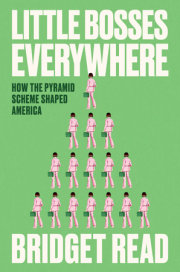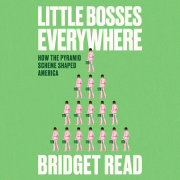1A Quintessential American AttitudeSitting on a bench under a tree in an office park in Buena Park, California, is a life-size bronze statue of an elderly man gazing out in contemplation. The same statue sits in a large corporate building in Beijing, China, in front of a rolltop desk covered in test tubes. The man also has an endowed professorship in his name at Stanford University’s Disease Prevention Research Center in Palo Alto, to “perpetuate his memory and ideals.” This is Carl F. Rehnborg, the grandfather of multi-level marketing.
Should a curious person want to know who invented MLM, a quick Google search will lead to Rehnborg, and to his accolades and institutional bona fides, including the statues and the endowed professorship. According to Stanford’s website, Rehnborg was a pioneering humanitarian who, in 1934, invented “what is believed to be the first multivitamin/multimineral dietary supplement marketed in the United States.” Rehnborg was inspired by time he spent in China observing wide-spread malnutrition, the website says. The vitamin supplement company he founded, Nutrilite, was also the first-ever company to use the multilevel marketing method—though Stanford doesn’t mention this accomplishment.
The Amway Corporation does, however, in a section of its own website called “Amway’s Impact on Direct Selling”: “To help distribute his Nutrilite line,” it says, “Rehnborg and his team were among the first to develop a compensation model for direct sellers sometimes called multi-level marketing.” Nutrilite eventually became part of Amway, which is why much of Rehnborg’s memory is kept alive by the company. It was Amway that endowed the Stanford professorship in 1989. Amway also commissioned the statues of Rehnborg, one in a building called the Amway Experience Center in Beijing, and the other in front of the clean, bright Nutrilite headquarters in Buena Park, called the Center for Optimal Health, which doubles as a small museum. Visitors can walk inside the metal hut where Rehnborg lived and filled his vitamins by hand when Nutrilite was in its infancy. Amway’s Independent Business Owners, the company’s name for its recruits, come from all over the world to visit the center and take pictures with the Rehnborg statue, putting their arms around its bronze neck.
Rehnborg begat Nutrilite, Nutrilite begat Amway, and the rest is history—that’s the official creation story of multilevel marketing, as told in the spotless halls of the Nutrilite Center for Optimal Health. Start to dig into it, however, and the whole thing comes to resemble a gleaming Potemkin village. Despite what the statues and the endowment might imply, despite black-and-white photographs of Rehnborg in a lab coat, and the many times he called himself doctor, Rehnborg wasn’t a scientist, a doctor, or even a researcher when he started his vitamin company. He was a salesman.
Before he aspired to end malnutrition, Carl Rehnborg aspired to be rich. His parents were Swedish immigrant artisans who sold paintings and jewelry to vacationers up and down the East Coast, in places like St. Augustine and Savannah, where, at the tail end of the nineteenth century, America’s industrialists spent their millions. Carl, born in 1887, was the oldest of five siblings, three boys and two girls, and the whole family moved with the seasons. A winter spent in Pinehurst, North Carolina, the world’s first golf resort, left a huge impression on the nineteen-year-old Rehnborg in 1906, according to
The Nutrilite Story, a 424-page tome published by the Amway Corporation in 2009. The Nutrilite Story, written by Rehnborg’s son, Carl Samuel “Sam” Rehnborg, Jr., who worked for his father and eventually for Amway, is the most robust—and only—public collection of primary sources on Rehnborg, the founding of Nutrilite, and the invention of MLM. It also functions as an extended Amway brochure, establishing Rehnborg as a brilliant autodidact with a genius IQ and multilevel marketing as a world-historical innovation on par with the advent of the internet.
Rehnborg’s trip to Pinehurst reportedly offered him a chance to hobnob among the leisure class, the du Ponts, Morgans, and Mellons, while he was “actively nurturing a dashing persona.” Sam Rehnborg writes that his father held a “quintessential American attitude”: he believed that “it took tenacity, intelligence, and hard work to make things happen rather than mere wealth.”
Though he was born in the Gilded Age, Rehnborg did not strike it rich the first time he tried, nor the second, nor the third as he made his way in the world. He had trouble committing to a trade, starting with selling jewelry for his parents, at which he failed. He moved to New York to become an actor, but instead he settled at the Pratt Institute to study in their jewelry design program, then dropped out—though, luckily for him, not before he met Hester Hawkes, a fellow Pratt student and Cape Cod heiress, who he eventually married in 1917. After that he was a streetcar conductor and a newspaper copy editor. At one point he invented a “revolutionary flooring material” that cracked in its first demonstration. He took a trip to Seattle in an attempt to join the Alaskan Gold Rush, but he arrived a few years too late. The gold was gone.
What Rehnborg lacked in consistency and follow-through, he seems to have made up for in charm and confidence. The Rehnborg boys were tall and good-looking, one family acquaintance said, and Carl in particular “knew what he wanted and went after it.” From an early age, his son chronicles, Rehnborg was a keen observer of people and a smooth talker—particularly with women. As a nineteen-year-old, he had written out a series of astute “rules” in his diary about how to court members of the opposite sex, which included number 5 (“Dance a few extra steps and seem loath to let her go”) and number 22 (“Carry yourself with confidence but not over-assurance, remember at the same time that everything is your fault”).
In 1915, at twenty-eight, Rehnborg accepted a job as an accountant with the Standard Oil Company of New York in Tianjin, then Tientsin, China. Being an American in China, even as a mere accountant, finally afforded him a taste of the tycoon’s lifestyle he had been dreaming about back home. He was assigned a house-boy, who laid out his white pongee suit and pith helmet every morning; he and Hester lived in the stately French concession of Tientsin, which was designed to look like Paris. The country had recently been opened up to foreign investment, and Rehnborg was surrounded by tales of wealthy men who had made their fortunes in the East, including his own boss at Standard Oil, John D. Rockefeller, already one of the richest men in the United States.
Rehnborg’s time in China is where multilevel marketing’s foundational lore begins. As
The Nutrilite Story tells it, Rehnborg became interested in the subject of nutrition when he observed the ill health of poor Chinese people while traveling around the country for Standard Oil. This is what kicked off Rehnborg’s “quest to create supplements,” per an Amway website page called “The Origins of Nutrilite: A Brand Ahead of Its Time.”
Rehnborg’s initial trip to China lasted less than a year. He then took short-lived jobs in Mexico and Texas before coming down with the Spanish flu in 1918. While convalescing in a hospital, according to
The Nutrilite Story, he came up with a brilliant plan for his first nutrition-based venture: bringing milk to the people of China. The Carnation Milk Company had already been established in the United States and Rehnborg decided the Chinese were an untapped market. After pitching his idea successfully to Carnation in New York, he returned to China and set up an agency in Shanghai.
Rehnborg, however, didn’t account for the fact that Chinese people are largely lactose intolerant. His potential Chinese customers not only disliked the taste of the Carnation milk; it made them sick. The business struggled to get off the ground, and eventually Rehnborg had to give it up entirely. In 1924, he pivoted again: If he couldn’t sell milk to the Chinese, he could sell them toothpaste and other goods, as a salesman for Colgate.
But that wouldn’t make him rich either. By 1927, the Chinese Civil War had begun, upending Rehnborg’s selling network. The international settlement in Shanghai where his family lived was essentially under siege for a time, with foreigners unable to leave the compound. This experience is another important chapter in Rehnborg’s vision quest, as told by his son: He had unwittingly been preparing for his time in captivity as a kind of extreme nutrition hobbyist. Sam Rehnborg writes that his father had long been experimenting on his wife and children by adding yeast to their cereal, concocting a “beverage made from infusions of rusty nails” for iron, and dusting food with powdered shells. He allegedly spread these tips to his fellow compatriots languishing in the settlement, as they tried to stave off scurvy. Eventually a truce was called, but the war had irreparably damaged his business. His wife, Hester, left him, and Rehnborg was so broke that Carnation, his old employer, had to pay for his trip home. His adventure abroad was over.
Copyright © 2025 by Bridget Read. All rights reserved. No part of this excerpt may be reproduced or reprinted without permission in writing from the publisher.










